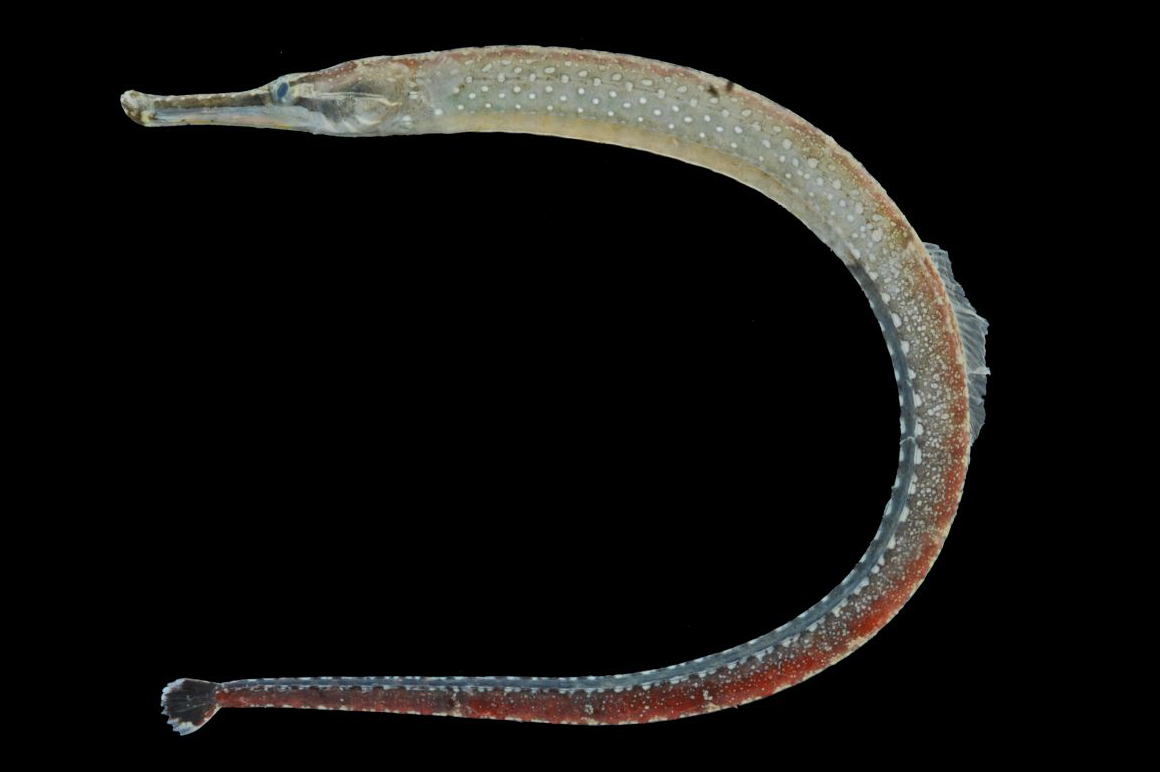Beady Pipefish, Hippichthys penicillus (Cantor 1850)

Beady Pipefish, Hippichthys penicillus. Source: Dinh D. Tran, FiMSeA / http://ffish.asia. License: CC by Attribution
A greenish to tan or brown pipefish with many dark-edged white spots on the sides, about 10 narrow pale bars across the back, tail rings usually with a semicircular pale blotch on or above the inferior ridge.
Beady Pipefish, Hippichthys penicillus (Cantor 1850)
More Info
|
Distribution |
Carnarvon, Western Australia, to Woy Woy, New South Wales. Elsewhere the species occurs in the tropical, Indo-west Pacific, from western Persian Gulf (Kuwait, Saudi Arabia), north central Indian Ocean, and eastward to Japan and Australia. Found in the lower reaches of streams and rivers, in estuarine seagrass beds and other shallow inshore habitats. |
|
Features |
Dorsal fin 25-30; Pectoral fin 15-18 (usually 17); Trunk rings 14-16; Total rings 36-41. Head length 6.9-10.3 in SL; snout moderately long, 1.8-2.1 in head length; snout depth 3.6-5.7 in snout length; median dorsal snout ridge low; keels typically present on some or most scutella; superior trunk and tail ridges discontinuous; inferior trunk and tail ridges continuous; lateral trunk ridge straight and not deflected ventrally near the anal ring. Dorsal fin usually originates on the 2nd-3rd tail ring, fin base not elevated. |
|
Size |
To 180 mm TL. |
|
Colour |
Generally tan, greenish or brown with numerous dark-edged white spots on sides and about 10 narrow pale bars across the back; sides of tail rings usually with a semicircular pale blotch on or above the inferior ridge. |
|
Feeding |
Feeds on small planktonic crustaceans. |
|
Biology |
Males incubate the eggs in a brood pouch under the tail. the pouch has protective plates and an everted pouch closure. Males may begin brooding at 100 mm SL. Males and females form monogamous pairs. Brood pouch eggs are oval and crowded in up to 10-11 transverse rows (typically in a single layer) across the upper part of pouch folds and dorsum of the pouch; not in a continuous gelatinous matrix but covered by protective folds which meet or overlap on ventral midline. |
|
Fisheries |
The Bellybar Pipefish may be collected for sale in the aquarium industry. |
|
Conservation |
Marine listed under the Environment Protection and Biodiversity Conservation Act 1999 and subject to the export controls of the Commonwealth Wildlife Protection (Regulation of Exports and Imports) Act 1982. |
|
Remarks |
Specimens from different geographic regions vary somewhat in morphology and further investigation may reveal that this variation represents a species complex. |
|
Etymology |
Hippichthys is from the Greek ippos, meaning horse and ichthys for fish. |
|
Species Citation |
Syngnathus penicillus Cantor 1850, J. Asiat. Soc. Bengal 18(2): 1368. Type locality: Sea of Pinang, Malaya. |
|
Author |
Thompson, V.J. & Bray, D.J. 2016 |
|
Resources |
Beady Pipefish, Hippichthys penicillus (Cantor 1850)
References
Allen, G.R. 1991. Field guide to the freshwater fishes of New Guinea. Christensen Research Institute, Madang, Papua New Guinea.
Allen, G.R. 1997. Marine Fishes of Tropical Australia and South-east Asia. Perth : Western Australian Museum 292 pp.
Allen, G.R., Midgley, S.H. & Allen, M. 2002. Field Guide to the Freshwater Fishes of Australia. Perth : Western Australian Museum 394 pp.
Allen, G.R. & Swainston, R. 1988. The Marine Fishes of North-Western Australia. A field guide for anglers and divers. Perth, WA : Western Australian Museum vi 201 pp., 70 pls.
Cantor, T.E. 1850. Catalogue of Malayan fishes. Journal of the Asiatic Society of Bengal 18(2): 983-1443 pls 1-14
Dahanukar, N. 2011. Hippichthys penicillus. The IUCN Red List of Threatened Species 2011: e.T172469A6898451. http://dx.doi.org/10.2305/IUCN.UK.2011-1.RLTS.T172469A6898451.en. Downloaded on 18 November 2016.
Dawson, C.E. 1984. Synopsis of Australian pipefishes usually referred to the syngnathine (tail-pouch) genera Syngnathus, Leptonotus and Histogamphelus. Memoirs of Museum Victoria 45: 71-123. (as Parasyngnathus penicillus) Ref at BHL
Dawson, C.E. 1985. Indo-Pacific Pipefishes (Red Sea to the Americas). Ocean Springs (Mississippi) : Gulf Coast Research Laboratory 230 pp.
Kuiter, R.H. 2000. Seahorses, Pipefishes and Their Relatives. Chorleywood, UK : TMC Publishing 240 pp.
Kuiter, R.H. 2009. Seahorses and their relatives. Seaford, Australia : Aquatic Photographics pp. 331.
Larson, H.K. & Williams, R.S. 1997. Darwin Harbour fishes: a survey and annotated checklist. pp. 339-380 in Hanley, H.R., Caswell, G., Megirian, D. & Larson, H.K. (eds) The Marine Flora and Fauna of Darwin Harbour, Northern Territory, Australia. Proceedings of the Sixth International Marine Biology Workshop. Darwin : Museum and Art Gallery of the Northern Territory 466 pp.
Ogilby, J.D. 1890. Descriptions of two new species of Australian lophobranchiate fishes. Records of the Australian Museum 1(3): 55-56 (described as Syngnathus altirostris)
Paulus, T. 1999. Family Syngnathidae. pp. 2264-2276 in Carpenter, K.E. & Niem, T.H. (eds) The Living Marine Resources of the Western Central Pacific. FAO Species Identification Guide for Fisheries Purposes. Rome : FAO Vol. 4 pp. 2069-2790.
Pogonoski, J.J., D.A. Pollard & J.R. Paxton. 2002. Conservation Overview and Action Plan for Australian Threatened and Potentially Threatened Marine and Estuarine Fishes, Environment Australia, Canberra. 375 pp. Available online at: http://www.environment.gov.au/coasts/publications/marine-fish-action/index.html
Watanabe, S., Y. Watanabe & M. Okiyama. 1997. Monogamous mating and conventional sex roles in Hippichthys penicillus (Syngnathidae) under laboratory conditions. Ichthyological Research 44: 306–310.
Weber, M. & L.F. De Beaufort. 1922. The fishes of the Indo-Australian Archipelago. IV. Heteromi, Solenichthyes, Synentognathi, Percesoces, Labyrinthici, Microcyprini. E. J. Brill, Leiden, 4:1-410.
Whiteman, E.A. & I.M. Côté. 2004. Monogamy in marine fishes. Biological Reviews 79: 351-375.
Whitley, G.P. 1947. New sharks and fishes from Western Australia. Part 3. The Australian Zoologist 11(2): 129-150 (described as Hippichthys gazella)
Whitley, G.P. 1957. The freshwater fishes of Australia. 11. Pipefishes, garfish, long tom and soles. Aqualife 2(8): 17-26 (as Parasyngnathus altirostris)




